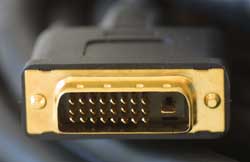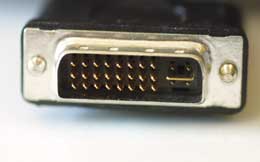What Kind of DVI Cable do I Need?
The variety of DVI connection types can be confusing, and if you use the wrong type of cable for the connection you need to make, your video won't get through. This article is meant to help you figure out just what type of connection will, or won't, work with your devices which have DVI sockets.
Two Signal Types:
In general, there are only two signal types which run through DVI connectors. The two types are digital and analog, and they are incompatible with one another. If you use a DVI cable to connect a device that sends out only digital signals to a device that accepts only analog signals, or vice versa, you'll get no signal; so the first question you have to answer is whether your devices can talk to each other at all.
The Digital Signal: "DVI-D"
The digital signal type that runs through a DVI cable is sometimes referred to as DVI-D. This format is completely incompatible with any analog signal format, and therefore cannot be connected to anything that doesn't also handle DVI-D or HDMI. If the socket on your device is a DVI-D socket (that is, if it lacks the four pin sockets for an analog signal which surround the broad flat "ground" pin; see photo at right) then this port will only handle DVI-D signals. It cannot be connected to any analog source, such as component video, composite video, VGA, or the like. It can, however, be connected to an HDMI device by using a DVI/HDMI cable.
But some devices which support DVI-D may not have a DVI-D socket. Instead, they may have a DVI-I socket, which does have four pin sockets around the flat ground pin. When a device has a DVI-I socket, it may be any of three types, and which of these it is can ordinarily be determined by consulting your user's manual:
(1) DVI-D only; this device has no signal available on the analog pins, but uses a DVI-I socket only to allow a DVI-I cable to be used;
(2) DVI-A only; this device has no DVI-D digital signal available, and is simply using a DVI socket as a port for accepting a regular analog signal format (usually RGBHV, which would include VGA). The device may be connected to any RGBHV device, using a DVI-I cable, a DVI/VGA cable, or a DVI breakout to five separate lines for R, G, B, H and V.
(3) True DVI-I; this device has both analog and digital capability through this port. It may autosense, using a digital signal if present or an analog signal if no digital signal is found, or the digital/analog mode may have to be selected manually by a switch or menu selection.
| DVI-D Plug: |
 |
| DVI-I Plug: |
 |
The Analog Signal: "DVI-A"
As we've indicated, a device which has the DVI-I style connection, with pins for an analog RGBHV signal, may accept RGBHV signals through the analog port. If this is the case, then it can be connected to a regular analog computer monitor signal (usually using a DVI to VGA adapter) or to any other RGBHV device (using, as appropriate, either a DVI to VGA adapter or a DVI breakout adapter which splits the signal out to five separate lines.
What Kind of Cable do I Need?
Once you know whether your devices are compatible, selecting a cable to connect them is relatively simple. While there are DVI-I cables available, which will handle both analog and digital signals in one cable, there is no good reason to use one; in any application, only the digital or the analog part of a DVI-I cable will get used, and it's crowded enough inside a DVI cable without adding a bunch of redundant cables to the bundle.
DVI Digital Connection Options:
If your signal will be digital, you should use a digital-only cable. If both devices use DVI connections, then you will want a regular DVI-D cable. If one end is DVI and the other HDMI, you'll want a DVI-D to HDMI cable.
DVI Analog connection options:
If you're running a relatively short length--say, ten feet or less--of cable, the handiest way to make the connection is to use a one-piece adapter cable. We offer cables with a DVI plug on one end, and a VGA ("HD15," or "DB15") plug on the other, as well as cables with a DVI plug on one end and five male BNC plugs on the other. Alternatively, if you have a VGA cable you want to use in this application, you can purchase a little hardshell DVI/VGA adapter and use that with your existing cable.
If your run will be longer, we suggest using a full-sized set of RGBHV cables to make the connection, terminated with male BNCs at one end, together with a breakout adapter with a male DVI plug and five female BNCs at the other. Many people don't like to use adapters, and we're often asked whether this will contribute to signal loss. The answer is a definite no; the whole point of going to a full-sized cable, in fact, is to minimize signal loss. The loss associated with running any significant distance in miniature cable of the type that will fit a DVI plug is much greater than the loss associated with making a BNC/BNC connection along the line, and not only is the total attenuation loss lower using full-sized cables, but the loss of signal quality from impedance mismatch is far lower; it's simply much easier to maintain tight impedance tolerance in a full-sized cable than in a miniature cable, because the dimensions are easier to control.


